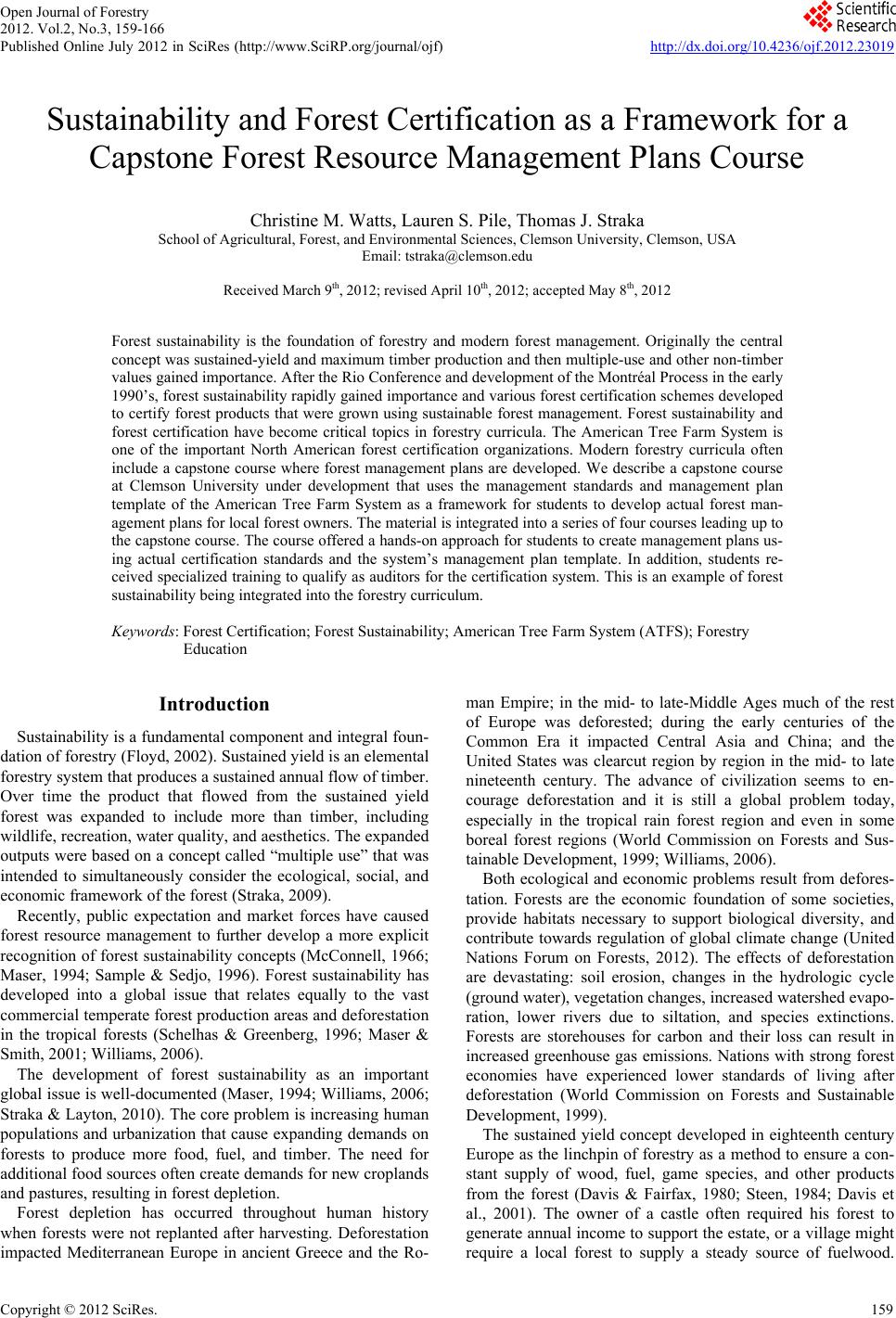 Open Journal of Forestry 2012. Vol.2, No.3, 159-166 Published Online July 2012 in SciRes (http://www.SciRP.org/journal/ojf) http://dx.doi.org/10.4236/ojf.2012.23019 Copyright © 2012 SciRes. 159 Sustainability and Forest Certification as a Framework for a Capstone Forest Resource Management Plans Course Christine M. Watts, Lauren S. Pile, Thomas J. Straka School of Agricult ural, Forest, and Environmental Sciences, Clemson University, Clemson, USA Email: tstraka@clemson . edu Received March 9th, 2012; re vis ed A pril 10th, 2012; accepted May 8th, 2012 Forest sustainability is the foundation of forestry and modern forest management. Originally the central concept was sustained-yield and maximum timber production and then multiple-use and other non-timber values gained importance. After the Rio Conference and development of the Montréal Process in the early 1990’s, forest sustainability rapidly gained importance and various forest certification schemes developed to certify forest products that were grown using sustainable forest management. Forest sustainability and forest certification have become critical topics in forestry curricula. The American Tree Farm System is one of the important North American forest certification organizations. Modern forestry curricula often include a capstone course where forest management plans are developed. We describe a capstone course at Clemson University under development that uses the management standards and management plan template of the American Tree Farm System as a framework for students to develop actual forest man- agement plans for local forest owners. The material is integrated into a series of four courses leading up to the capstone course. The course offered a hands-on approach for students to create management plans us- ing actual certification standards and the system’s management plan template. In addition, students re- ceived specialized training to qualify as auditors for the certification system. This is an example of forest sustainability being integrated into the forestry curriculum. Keywords: Forest Certification; Forest Sustainability; American Tree Farm System (ATFS); Forestry Education Introduction Sustainability is a fundamental component and integral foun- dation of forestry (Floyd, 2002). Sustained yield is an elemental forestry system that produces a sustained annual flow of timber. Over time the product that flowed from the sustained yield forest was expanded to include more than timber, including wildlife, recreation, water quality, and aesthetics. The expanded outputs were based on a concept called “multiple use” that was intended to simultaneously consider the ecological, social, and economic framework of the forest (Straka, 2009). Recently, public expectation and market forces have caused forest resource management to further develop a more explicit recognition of forest sustainability concepts (McConnell, 1966; Maser, 1994; Sample & Sedjo, 1996). Forest sustainability has developed into a global issue that relates equally to the vast commercial temperate forest production areas and deforestation in the tropical forests (Schelhas & Greenberg, 1996; Maser & Smith, 2001; Williams, 2006). The development of forest sustainability as an important global issue is well-documented (Maser, 1994; Williams, 2006; Straka & Layton, 2010). The core problem is increasing human populations and urbanization that cause expanding demands on forests to produce more food, fuel, and timber. The need for additional food sources often create demands for new croplands and pastures, resulting in forest depletion. Forest depletion has occurred throughout human history when forests were not replanted after harvesting. Deforestation impacted Mediterranean Europe in ancient Greece and the Ro- man Empire; in the mid- to late-Middle Ages much of the rest of Europe was deforested; during the early centuries of the Common Era it impacted Central Asia and China; and the United States was clearcut region by region in the mid- to late nineteenth century. The advance of civilization seems to en- courage deforestation and it is still a global problem today, especially in the tropical rain forest region and even in some boreal forest regions (World Commission on Forests and Sus- tainable Development, 1999; Williams, 2006). Both ecological and economic problems result from defores- tation. Forests are the economic foundation of some societies, provide habitats necessary to support biological diversity, and contribute towards regulation of global climate change (United Nations Forum on Forests, 2012). The effects of deforestation are devastating: soil erosion, changes in the hydrologic cycle (ground water), vegetation changes, increased watershed evapo- ration, lower rivers due to siltation, and species extinctions. Forests are storehouses for carbon and their loss can result in increased greenhouse gas emissions. Nations with strong forest economies have experienced lower standards of living after deforestation (World Commission on Forests and Sustainable Development, 1999). The sustained yield concept developed in eighteenth century Europe as the linchpin of forestry as a method to ensure a con- stant supply of wood, fuel, game species, and other products from the forest (Davis & Fairfax, 1980; Steen, 1984; Davis et al., 2001). The owner of a castle often required his forest to generate annual income to support the estate, or a village might require a local forest to supply a steady source of fuelwood. 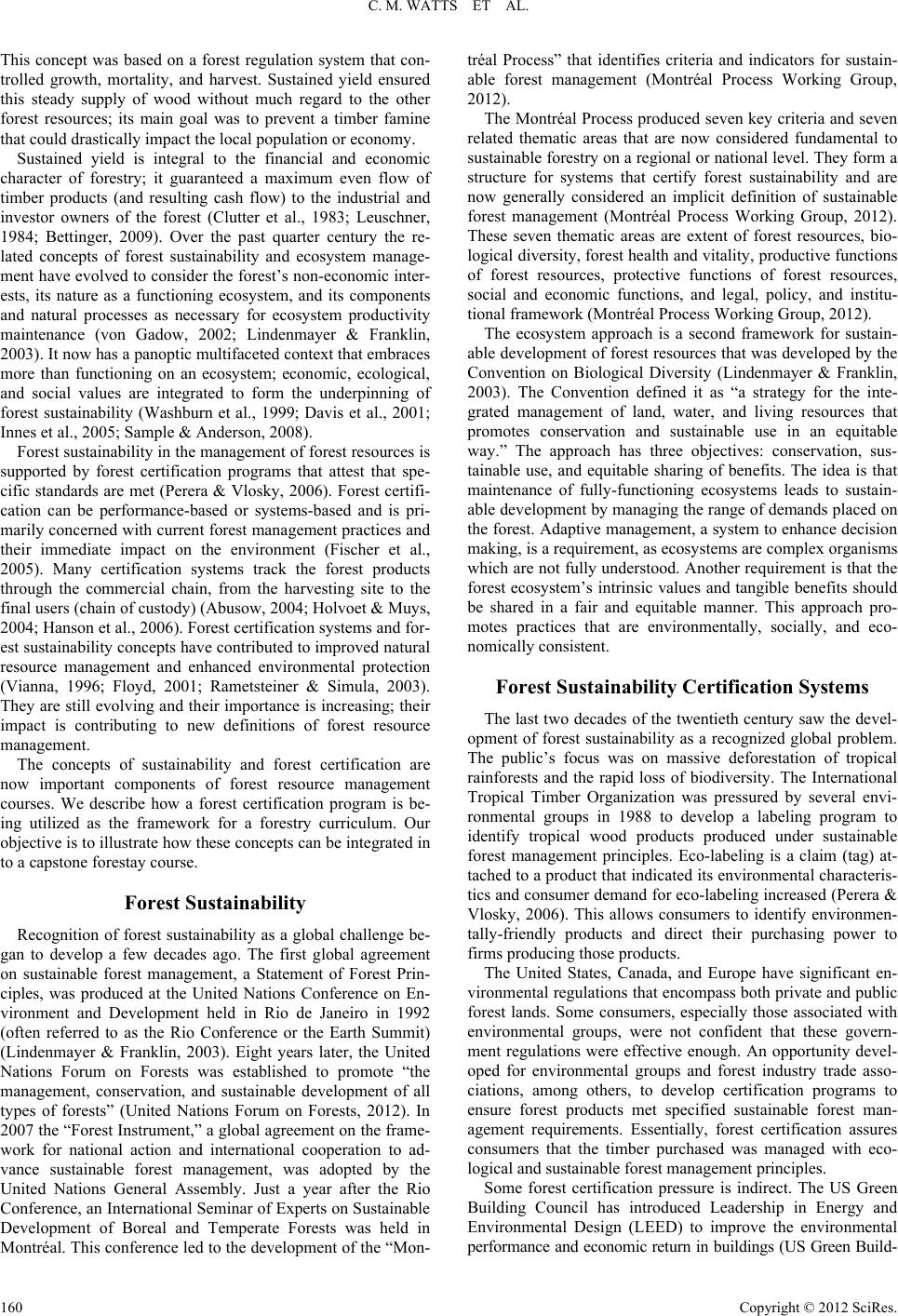 C. M. WATTS ET AL. This concept was based on a forest regulation system that con- trolled growth, mortality, and harvest. Sustained yield ensured this steady supply of wood without much regard to the other forest resources; its main goal was to prevent a timber famine that could drastically impact the local populati o n or economy. Sustained yield is integral to the financial and economic character of forestry; it guaranteed a maximum even flow of timber products (and resulting cash flow) to the industrial and investor owners of the forest (Clutter et al., 1983; Leuschner, 1984; Bettinger, 2009). Over the past quarter century the re- lated concepts of forest sustainability and ecosystem manage- ment have evolved to consider the forest’s non-economic inter- ests, its nature as a functioning ecosystem, and its components and natural processes as necessary for ecosystem productivity maintenance (von Gadow, 2002; Lindenmayer & Franklin, 2003). It now has a panoptic multifaceted context that embraces more than functioning on an ecosystem; economic, ecological, and social values are integrated to form the underpinning of forest sustainability (Washburn et al., 1999; Davis et al., 2001; Innes et al., 2005; Sample & Anderson, 2008). Forest sustainability in the management of forest resources is supported by forest certification programs that attest that spe- cific standards are met (Perera & Vlosky, 2006). Forest certifi- cation can be performance-based or systems-based and is pri- marily concerned with current forest management practices and their immediate impact on the environment (Fischer et al., 2005). Many certification systems track the forest products through the commercial chain, from the harvesting site to the final users (chain of custody) (Abusow, 2004; Holvoet & Muys, 2004; Hanson et al., 2006). Forest certification systems and for- est sustainability concepts have contributed to improved natural resource management and enhanced environmental protection (Vianna, 1996; Floyd, 2001; Rametsteiner & Simula, 2003). They are still evolving and their importance is increasing; their impact is contributing to new definitions of forest resource management. The concepts of sustainability and forest certification are now important components of forest resource management courses. We describe how a forest certification program is be- ing utilized as the framework for a forestry curriculum. Our objective is to illustrate how these concepts can be integrated in to a capstone forestay course. Forest Sustainability Recognition of forest sustainability as a global challenge be- gan to develop a few decades ago. The first global agreement on sustainable forest management, a Statement of Forest Prin- ciples, was produced at the United Nations Conference on En- vironment and Development held in Rio de Janeiro in 1992 (often referred to as the Rio Conference or the Earth Summit) (Lindenmayer & Franklin, 2003). Eight years later, the United Nations Forum on Forests was established to promote “the management, conservation, and sustainable development of all types of forests” (United Nations Forum on Forests, 2012). In 2007 the “Forest Instrument,” a global agreement on the frame- work for national action and international cooperation to ad- vance sustainable forest management, was adopted by the United Nations General Assembly. Just a year after the Rio Conference, an International Seminar of Experts on Sustainable Development of Boreal and Temperate Forests was held in Montréal. This conference led to the development of the “Mon- tréal Process” that identifies criteria and indicators for sustain- able forest management (Montréal Process Working Group, 2012). The Montréal Process produced seven key criteria and seven related thematic areas that are now considered fundamental to sustainable forestry on a regional or national level. They form a structure for systems that certify forest sustainability and are now generally considered an implicit definition of sustainable forest management (Montréal Process Working Group, 2012). These seven thematic areas are extent of forest resources, bio- logical diversity, forest health and vitality, productive functions of forest resources, protective functions of forest resources, social and economic functions, and legal, policy, and institu- tional framework (Montréal Process Working Group, 2012). The ecosystem approach is a second framework for sustain- able development of forest resources that was developed by the Convention on Biological Diversity (Lindenmayer & Franklin, 2003). The Convention defined it as “a strategy for the inte- grated management of land, water, and living resources that promotes conservation and sustainable use in an equitable way.” The approach has three objectives: conservation, sus- tainable use, and equitable sharing of benefits. The idea is that maintenance of fully-functioning ecosystems leads to sustain- able development by managing the range of demands placed on the forest. Adaptive management, a system to enhance decision making, is a requirement, as ecosystems are complex organisms which are not fully understood. Another requirement is that the forest ecosystem’s intrinsic values and tangible benefits should be shared in a fair and equitable manner. This approach pro- motes practices that are environmentally, socially, and eco- nomically consistent. Forest Sustainability Certification Systems The last two decades of the twentieth century saw the devel- opment of forest sustainability as a recognized global problem. The public’s focus was on massive deforestation of tropical rainforests and the rapid loss of biodiversity. The International Tropical Timber Organization was pressured by several envi- ronmental groups in 1988 to develop a labeling program to identify tropical wood products produced under sustainable forest management principles. Eco-labeling is a claim (tag) at- tached to a product that indicated its environmental characteris- tics and consumer demand for eco-labeling increased (Perera & Vlosky, 2006). This allows consumers to identify environmen- tally-friendly products and direct their purchasing power to firms producing those products. The United States, Canada, and Europe have significant en- vironmental regulations that encompass both private and public forest lands. Some consumers, especially those associated with environmental groups, were not confident that these govern- ment regulations were effective enough. An opportunity devel- oped for environmental groups and forest industry trade asso- ciations, among others, to develop certification programs to ensure forest products met specified sustainable forest man- agement requirements. Essentially, forest certification assures consumers that the timber purchased was managed with eco- logical and sustainable forest management principles. Some forest certification pressure is indirect. The US Green Building Council has introduced Leadership in Energy and Environmental Design (LEED) to improve the environmental performance and economic return in buildings (US Green Buil d- Copyright © 2012 SciRes. 160 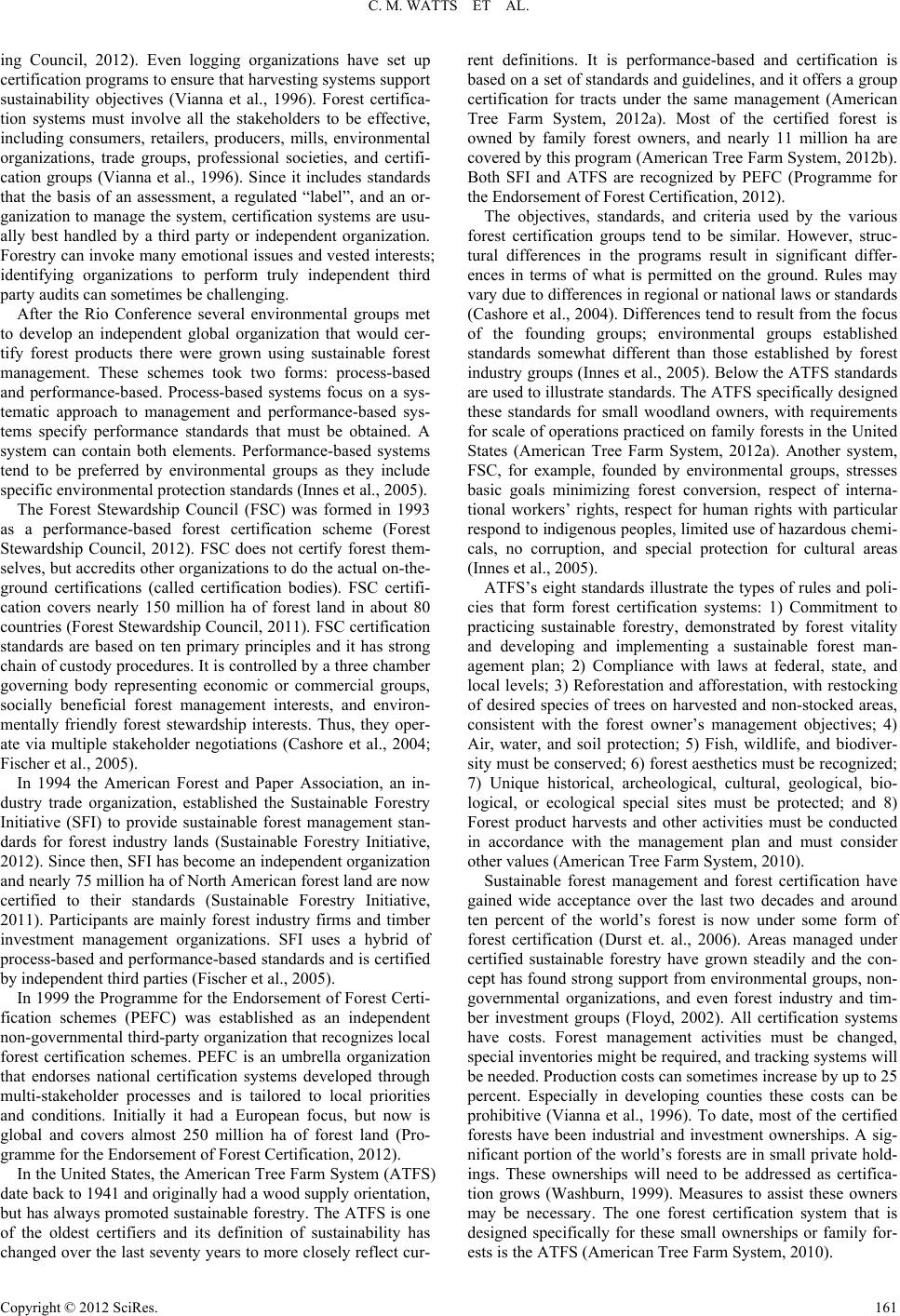 C. M. WATTS ET AL. ing Council, 2012). Even logging organizations have set up certification programs to ensure that harvesting systems support sustainability objectives (Vianna et al., 1996). Forest certifica- tion systems must involve all the stakeholders to be effective, including consumers, retailers, producers, mills, environmental organizations, trade groups, professional societies, and certifi- cation groups (Vianna et al., 1996). Since it includes standards that the basis of an assessment, a regulated “label”, and an or- ganization to manage the system, certification systems are usu- ally best handled by a third party or independent organization. Forestry can invoke many emotional issues and vested interests; identifying organizations to perform truly independent third party audits can sometimes be challenging. After the Rio Conference several environmental groups met to develop an independent global organization that would cer- tify forest products there were grown using sustainable forest management. These schemes took two forms: process-based and performance-based. Process-based systems focus on a sys- tematic approach to management and performance-based sys- tems specify performance standards that must be obtained. A system can contain both elements. Performance-based systems tend to be preferred by environmental groups as they include specific environmental protection standards (Innes et al., 2005). The Forest Stewardship Council (FSC) was formed in 1993 as a performance-based forest certification scheme (Forest Stewardship Council, 2012). FSC does not certify forest them- selves, but accredits other organizations to do the actual on-the- ground certifications (called certification bodies). FSC certifi- cation covers nearly 150 million ha of forest land in about 80 countries (Forest Stewardship Council, 2011). FSC certification standards are based on ten primary principles and it has strong chain of custody procedures. It is controlled by a three chamber governing body representing economic or commercial groups, socially beneficial forest management interests, and environ- mentally friendly forest stewardship interests. Thus, they oper- ate via multiple stakeholder negotiations (Cashore et al., 2004; Fischer et al., 2005). In 1994 the American Forest and Paper Association, an in- dustry trade organization, established the Sustainable Forestry Initiative (SFI) to provide sustainable forest management stan- dards for forest industry lands (Sustainable Forestry Initiative, 2012). Since then, SFI has become an independent organization and nearly 75 million ha of North American forest land are now certified to their standards (Sustainable Forestry Initiative, 2011). Participants are mainly forest industry firms and timber investment management organizations. SFI uses a hybrid of process-based and performance-based standards and is certified by independent third parties (Fischer et al., 2005). In 1999 the Programme for the Endorsement of Forest Certi- fication schemes (PEFC) was established as an independent non-governmental third-party organization that recognizes local forest certification schemes. PEFC is an umbrella organization that endorses national certification systems developed through multi-stakeholder processes and is tailored to local priorities and conditions. Initially it had a European focus, but now is global and covers almost 250 million ha of forest land (Pro- gramme for the Endorsement of Forest Certification, 2012). In the United States, the American Tree Farm System (ATFS) date back to 1941 and originally had a wood supply orientation, but has always promoted sustainable forestry . The ATFS is one of the oldest certifiers and its definition of sustainability has changed over the last seventy years to more closely reflect cur- rent definitions. It is performance-based and certification is based on a set of standards and guidelines, and it offers a group certification for tracts under the same management (American Tree Farm System, 2012a). Most of the certified forest is owned by family forest owners, and nearly 11 million ha are covered by this program (American Tree Farm System, 2012b). Both SFI and ATFS are recognized by PEFC (Programme for the Endorsement of Forest Certification, 2012). The objectives, standards, and criteria used by the various forest certification groups tend to be similar. However, struc- tural differences in the programs result in significant differ- ences in terms of what is permitted on the ground. Rules may vary due to differences in regional or national laws or standards (Cashore et al., 2004). Differences tend to result from the focus of the founding groups; environmental groups established standards somewhat different than those established by forest industry groups (Innes et al., 2005). Below the ATFS standards are used to illustrate standards. The ATFS specifically designed these standards for small woodland owners, with requirements for scale of operations practiced on family forests in the United States (American Tree Farm System, 2012a). Another system, FSC, for example, founded by environmental groups, stresses basic goals minimizing forest conversion, respect of interna- tional workers’ rights, respect for human rights with particular respond to indigenous peoples, limited use of hazardous chemi- cals, no corruption, and special protection for cultural areas (Innes et al., 2005). ATFS’s eight standards illustrate the types of rules and poli- cies that form forest certification systems: 1) Commitment to practicing sustainable forestry, demonstrated by forest vitality and developing and implementing a sustainable forest man- agement plan; 2) Compliance with laws at federal, state, and local levels; 3) Reforestation and afforestation, with restocking of desired species of trees on harvested and non-stocked areas, consistent with the forest owner’s management objectives; 4) Air, water, and soil protection; 5) Fish, wildlife, and biodiver- sity must be conserved; 6) forest aesthetics must be recognized; 7) Unique historical, archeological, cultural, geological, bio- logical, or ecological special sites must be protected; and 8) Forest product harvests and other activities must be conducted in accordance with the management plan and must consider other values (American Tree Farm System, 2010). Sustainable forest management and forest certification have gained wide acceptance over the last two decades and around ten percent of the world’s forest is now under some form of forest certification (Durst et. al., 2006). Areas managed under certified sustainable forestry have grown steadily and the con- cept has found strong support from environmental groups, non- governmental organizations, and even forest industry and tim- ber investment groups (Floyd, 2002). All certification systems have costs. Forest management activities must be changed, special inventories might be required, and tracking systems will be needed. Production costs can sometimes increase by up to 25 percent. Especially in developing counties these costs can be prohibitive (Vianna et al., 1996). To date, most of the certified forests have been industrial and investment ownerships. A sig- nificant portion of the world’s forests are in small private hold- ings. These ownerships will need to be addressed as certifica- tion grows (Washburn, 1999). Measures to assist these owners may be necessary. The one forest certification system that is designed specifically for these small ownerships or family for- ests is the ATFS (American Tree Farm System, 2010). Copyright © 2012 SciRes. 161 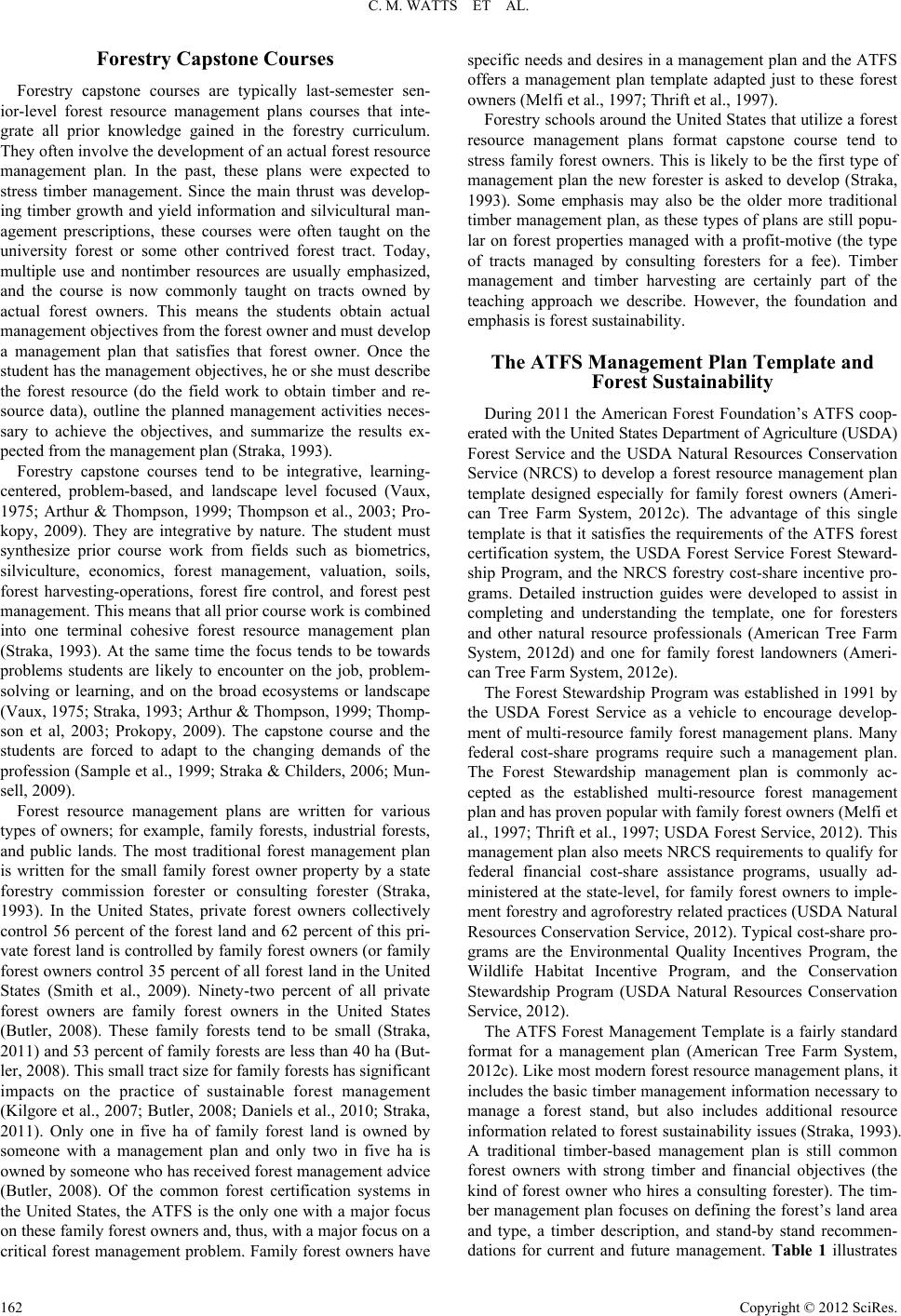 C. M. WATTS ET AL. Forestry Capstone Courses Forestry capstone courses are typically last-semester sen- ior-level forest resource management plans courses that inte- grate all prior knowledge gained in the forestry curriculum. They often involve the development of an actual forest resource management plan. In the past, these plans were expected to stress timber management. Since the main thrust was develop- ing timber growth and yield information and silvicultural man- agement prescriptions, these courses were often taught on the university forest or some other contrived forest tract. Today, multiple use and nontimber resources are usually emphasized, and the course is now commonly taught on tracts owned by actual forest owners. This means the students obtain actual management objectives from the forest owner and must develop a management plan that satisfies that forest owner. Once the student has the management objectives, he or she must describe the forest resource (do the field work to obtain timber and re- source data), outline the planned management activities neces- sary to achieve the objectives, and summarize the results ex- pected from the management plan (Straka, 1993). Forestry capstone courses tend to be integrative, learning- centered, problem-based, and landscape level focused (Vaux, 1975; Arthur & Thompson, 1999; Thompson et al., 2003; Pro- kopy, 2009). They are integrative by nature. The student must synthesize prior course work from fields such as biometrics, silviculture, economics, forest management, valuation, soils, forest harvesting-operations, forest fire control, and forest pest management. T his means that all prior course work is combined into one terminal cohesive forest resource management plan (Straka, 1993). At the same time the focus tends to be towards problems students are likely to encounter on the job, problem- solving or learning, and on the broad ecosystems or landscape (Vaux, 1975; Straka, 1993; Arthur & Thompson, 1999; Thomp- son et al, 2003; Prokopy, 2009). The capstone course and the students are forced to adapt to the changing demands of the profession (Sample et al., 1999; Straka & Childers, 2006; Mun- sell, 2009). Forest resource management plans are written for various types of owners; for example, family forests, industrial forests, and public lands. The most traditional forest management plan is written for the small family forest owner property by a state forestry commission forester or consulting forester (Straka, 1993). In the United States, private forest owners collectively control 56 percent of the forest land and 62 percent of this pri- vate forest land is controlled by family forest owners (or family forest owners control 35 percent of all forest land in the United States (Smith et al., 2009). Ninety-two percent of all private forest owners are family forest owners in the United States (Butler, 2008). These family forests tend to be small (Straka, 2011) and 53 percent of family forests are less than 40 ha (But- ler, 2008). This small tract size for family forests has significant impacts on the practice of sustainable forest management (Kilgore et al., 2007; Butler, 2008; Daniels et al., 2010; Straka, 2011). Only one in five ha of family forest land is owned by someone with a management plan and only two in five ha is owned by someone who has received forest management advice (Butler, 2008). Of the common forest certification systems in the United States, the ATFS is the only one with a major focus on these family forest owners and, thus, with a major focus on a critical forest management problem. Family forest owners have specific needs and desires in a management plan and the ATFS offers a management plan template adapted just to these forest owners (Melfi et al., 1997; Thrift et al., 1997). Forestry schools around the United States that utilize a forest resource management plans format capstone course tend to stress family forest owners. This is likely to be the first type of management plan the new forester is asked to develop (Straka, 1993). Some emphasis may also be the older more traditional timber management plan, as these types of plans are still popu- lar on forest properties managed with a profit-motive (the type of tracts managed by consulting foresters for a fee). Timber management and timber harvesting are certainly part of the teaching approach we describe. However, the foundation and emphasis is forest sustainability. The ATFS Management Plan Template and Forest Sustainability During 2011 the American Forest Foundation’s ATFS coop- erated with the United States Department of Agriculture (USDA) Forest Service and the USDA Natural Resources Conservation Service (NRCS) to develop a forest resource management plan template designed especially for family forest owners (Ameri- can Tree Farm System, 2012c). The advantage of this single template is that it satisfies the requirements of the ATFS forest certification system, the USDA Forest Service Forest Steward- ship Program, and the NRCS forestry cost-share incentive pro- grams. Detailed instruction guides were developed to assist in completing and understanding the template, one for foresters and other natural resource professionals (American Tree Farm System, 2012d) and one for family forest landowners (Ameri- can Tree Farm System, 2012e). The Forest Stewardship Program was established in 1991 by the USDA Forest Service as a vehicle to encourage develop- ment of multi-resource family forest management plans. Many federal cost-share programs require such a management plan. The Forest Stewardship management plan is commonly ac- cepted as the established multi-resource forest management plan and has proven popular with family forest owners (Melfi et al., 1997; Thrift et al., 1997; USDA Forest Service, 2012). This management plan also meets NRCS requirements to qualify for federal financial cost-share assistance programs, usually ad- ministered at the state-level, for family forest owners to imple- ment forestry and agroforestry related practices (USDA Natural Resources Conservation Service, 2012). Typical cost-share pro- grams are the Environmental Quality Incentives Program, the Wildlife Habitat Incentive Program, and the Conservation Stewardship Program (USDA Natural Resources Conservation Service, 2012). The ATFS Forest Management Template is a fairly standard format for a management plan (American Tree Farm System, 2012c). Like most modern forest resource management plans, it includes the basic timber management information necessary to manage a forest stand, but also includes additional resource information related to forest sustainability issues (Straka, 1993). A traditional timber-based management plan is still common forest owners with strong timber and financial objectives (the kind of forest owner who hires a consulting forester). The tim- ber management plan focuses on defining the forest’s land area and type, a timber description, and stand-by stand recommen- dations for current and future management. Table 1 illustrates Copyright © 2012 SciRes. 162 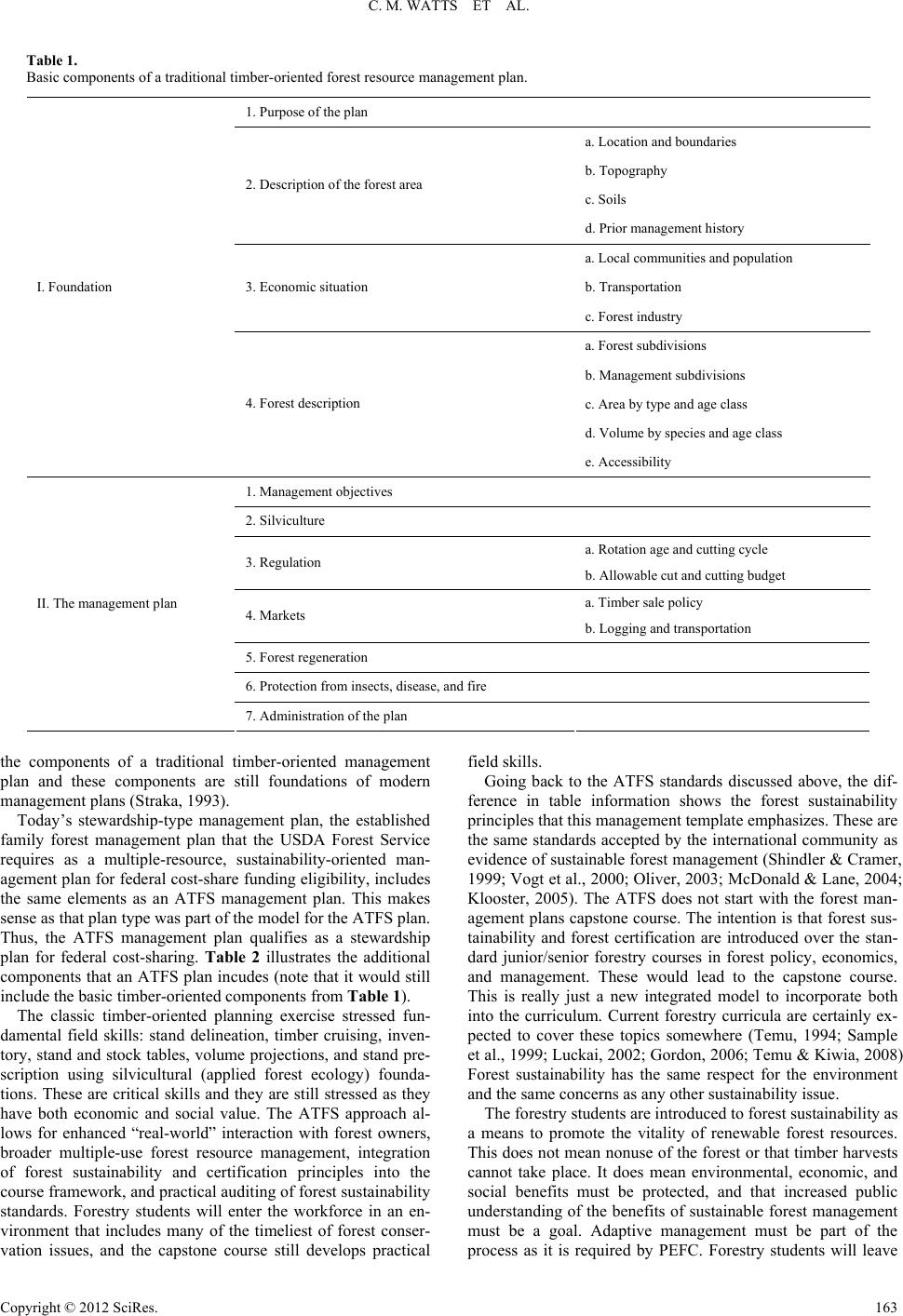 C. M. WATTS ET AL. Copyright © 2012 SciRes. 163 Table 1. Basic components of a t raditional timber-oriented forest resource management pla n. 1. Purpose of the plan a. Location and boundaries b. Topography c. Soils 2. Descriptio n of the forest area d. Prior management history a. Local communities and population b. Transportation 3. Economic situation c. Forest ind u stry a. Forest sub divisions b. Management subdivisions c. Area by type and age class d. Volume by species and age class I. Foundation 4. Forest description e. Accessibility 1. Management objectives 2. Silviculture a. Rotation age and cutting cycle 3. Regulation b. Allowable cut and cutting budget a. Timber sale policy 4. Markets b. Logging a nd transportation 5. Forest regeneration 6. Protec ti o n from insec t s , disease, and fire II. The management plan 7. Administration of the plan the components of a traditional timber-oriented management plan and these components are still foundations of modern management plans (Straka, 1993). Today’s stewardship-type management plan, the established family forest management plan that the USDA Forest Service requires as a multiple-resource, sustainability-oriented man- agement plan for federal cost-share funding eligibility, includes the same elements as an ATFS management plan. This makes sense as that plan type was part of the model for the ATFS plan. Thus, the ATFS management plan qualifies as a stewardship plan for federal cost-sharing. Table 2 illustrates the additional components that an ATFS plan incudes (note that it would still include the basic timber-oriented components from Table 1). The classic timber-oriented planning exercise stressed fun- damental field skills: stand delineation, timber cruising, inven- tory, stand and stock tables, volume projections, and stand pre- scription using silvicultural (applied forest ecology) founda- tions. These are critical skills and they are still stressed as they have both economic and social value. The ATFS approach al- lows for enhanced “real-world” interaction with forest owners, broader multiple-use forest resource management, integration of forest sustainability and certification principles into the course framework, and practical auditing of forest sustainability standards. Forestry students will enter the workforce in an en- vironment that includes many of the timeliest of forest conser- vation issues, and the capstone course still develops practical field skills. Going back to the ATFS standards discussed above, the dif- ference in table information shows the forest sustainability principles that this management template emphasizes. These are the same standards accepted by the international community as evidence of sustainable forest management (Shindler & Cramer, 1999; Vogt et al., 2000; Oliver, 2003; McDonald & Lane, 2004; Klooster, 2005). The ATFS does not start with the forest man- agement plans capstone course. The intention is that forest sus- tainability and forest certification are introduced over the stan- dard junior/senior forestry courses in forest policy, economics, and management. These would lead to the capstone course. This is really just a new integrated model to incorporate both into the curriculum. Current forestry curricula are certainly ex- pected to cover these topics somewhere (Temu, 1994; Sample et al., 1999; Luckai, 2002; Gordon, 2006; Temu & Kiwia, 2008) Forest sustainability has the same respect for the environment and the same concerns as any other sustainability issue. The forestry students are introduced to forest sustainability as a means to promote the vitality of renewable forest resources. This does not mean nonuse of the forest or that timber harvests cannot take place. It does mean environmental, economic, and social benefits must be protected, and that increased public understanding of the benefits of sustainable forest management must be a goal. Adaptive management must be part of the rocess as it is required by PEFC. Forestry students will leave p 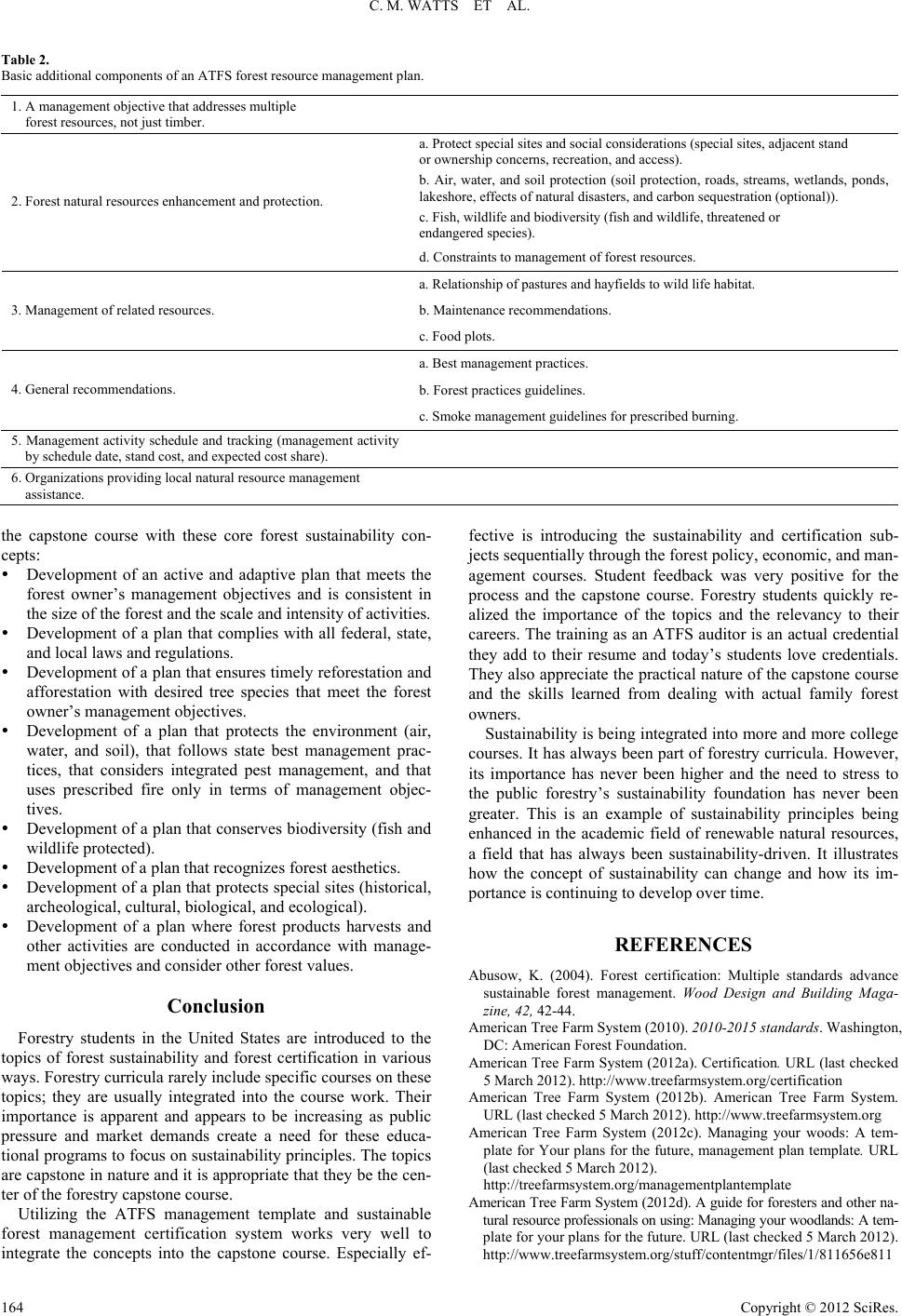 C. M. WATTS ET AL. Table 2. Basic add it i on al components of an ATFS forest resource management plan. 1. A management obje ctive that addresses multiple forest resources, not just timber. a. Protect special sites and social considerations (special sites, adjacent stand or ownership concerns, recreation, and access). b. Air, water, and soil protection (soil protection, roads, streams, wetlands, ponds, lakeshore, effects of natural disasters, and carbon sequestration (optional)). c. Fish, wildlife and biodiversity (fish and wildlife, threatened or endangered species). 2. Forest natural resourc es enhance ment and prote ction. d. Constra i nts to management of forest resources. a. Relationship of pasture s and hayfields t o w i l d life habitat. b. Maintenance recommendations. 3. Management of relat ed resources. c. Food plots. a. Best management practices. b. Forest practices guidelines. 4. General recommendations. c. Smoke management guidelines for prescribed burning. 5. Management activity schedule and tracking (management activity by schedule date, stand cost, and expected cost share). 6. Organizations providing local natural resourc e manageme n t assistance. the capstone course with these core forest sustainability con- cepts: Development of an active and adaptive plan that meets the forest owner’s management objectives and is consistent in the size of the forest and the scale and intensity of activities. Development of a plan that complies with all federal, state, and local laws and regulations. Development of a plan that ensures timely reforestation and afforestation with desired tree species that meet the forest owner’s management objectives. Development of a plan that protects the environment (air, water, and soil), that follows state best management prac- tices, that considers integrated pest management, and that uses prescribed fire only in terms of management objec- tives. Development of a plan that conserves biodiversity (fish and wildlife protected). Development of a plan that recognizes forest aesthetics. Development of a plan that protects special sites (historical, archeological, cu ltural, biological, and ecological). Development of a plan where forest products harvests and other activities are conducted in accordance with manage- ment objectives and consider other forest values. Conclusion Forestry students in the United States are introduced to the topics of forest sustainability and forest certification in various ways. Forestry curricula rarely include specific courses on these topics; they are usually integrated into the course work. Their importance is apparent and appears to be increasing as public pressure and market demands create a need for these educa- tional programs to focus on sustainability principles. The topics are capstone in nature and it is appropriate that they be the cen- ter of the forestry capstone course. Utilizing the ATFS management template and sustainable forest management certification system works very well to integrate the concepts into the capstone course. Especially ef- fective is introducing the sustainability and certification sub- jects sequentially through the forest policy, economic, and man- agement courses. Student feedback was very positive for the process and the capstone course. Forestry students quickly re- alized the importance of the topics and the relevancy to their careers. The training as an ATFS auditor is an actual credential they add to their resume and today’s students love credentials. They also appreciate the practical nature of the capstone course and the skills learned from dealing with actual family forest owners. Sustainability is being integrated into more and more college courses. It has always been part of forestry curricula. However, its importance has never been higher and the need to stress to the public forestry’s sustainability foundation has never been greater. This is an example of sustainability principles being enhanced in the academic field of renewable natural resources, a field that has always been sustainability-driven. It illustrates how the concept of sustainability can change and how its im- portance is continuing to develop over time. REFERENCES Abusow, K. (2004). Forest certification: Multiple standards advance sustainable forest management. Wood Design and Building Maga- zine, 42, 42-44. American Tree Farm System (2010). 2010-2015 standards. Washington, DC: American Forest Foundation. American Tree Farm System (2012a). Certification. URL (last checked 5 March 2012). http://www.treefarmsystem.org/certification American Tree Farm System (2012b). American Tree Farm System. URL (last checked 5 March 2012). http://ww w.treefarmsystem.org American Tree Farm System (2012c). Managing your woods: A tem- plate for Your plans for the future, management plan template. URL (last checked 5 March 2012). http://treefarmsystem.org/managementplantemplate American Tree Farm System (2012d). A guide for foresters and other na- tural resource profession als on using: Managing your woodlands: A te m- plate for your plans for the future. URL (last checked 5 March 2012). http://www.treefarmsystem.org/stuff/contentmgr/files/1/811656e811 Copyright © 2012 SciRes. 164 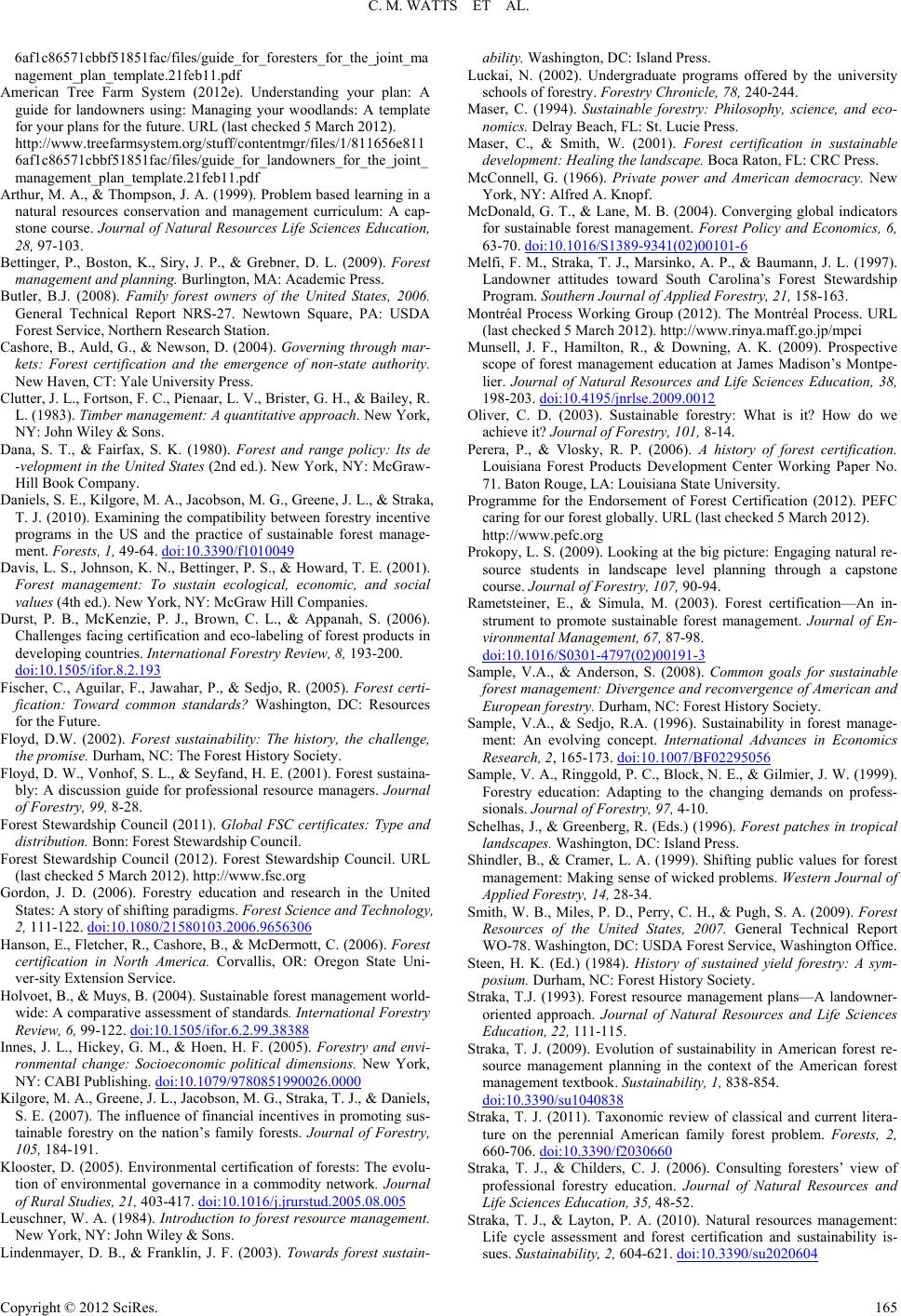 C. M. WATTS ET AL. 6af1c86571cbbf51851fac/files/guide_for_foresters_for_the_joint_ma nagement_plan_template.21feb11.pdf American Tree Farm System (2012e). Understanding your plan: A guide for landowners using: Managing your woodlands: A template for your plans for the future. URL (last checked 5 March 2012). http://www.treefarmsystem.org/stuff/contentmgr/files/1/811656e811 6af1c86571cbbf51851fac/files/guide_for_landowners_for_the_joint_ management_plan_template.21feb11.pdf Arthur, M. A., & Thompson, J. A. (1999). Problem based learning in a natural resources conservation and management curriculum: A cap- stone course. Journal of Natural Resources Life Sciences Education, 28, 97-103. Bettinger, P., Boston, K., Siry, J. P., & Grebner, D. L. (2009). Forest management and planning. Burlington, MA: Academic Press. Butler, B.J. (2008). Family forest owners of the United States, 2006. General Technical Report NRS-27. Newtown Square, PA: USDA Forest Service, Northern Research Station. Cashore, B., Auld, G., & Newson, D. (2004). Governing through mar- kets: Forest certification and the emergence of non-state authority. New Haven, CT: Yale University Press. Clutter, J. L., Fortson, F. C., Pienaar, L. V., Brister, G. H., & Bailey, R. L. (1983). Timber management: A quantitative approach. New York, NY: John Wiley & Sons. Dana, S. T., & Fairfax, S. K. (1980). Forest and range policy: Its de -velopment in the United States (2nd ed.). New York, NY: McGraw- Hill Book Company. Daniels, S. E., Kil gore, M. A., Ja cobson, M. G., Greene, J. L., & Straka, T. J. (2010). Examining the compatibility between forestry incentive programs in the US and the practice of sustainable forest manage- ment. Forests, 1, 49-64. doi:10.3390/f1010049 Davis, L. S., Johnson, K. N., Bettinger, P. S., & Howard, T. E. (2001). Forest management: To sustain ecological, economic, and social values (4th ed.). New York, NY: McGraw Hill Companies. Durst, P. B., McKenzie, P. J., Brown, C. L., & Appanah, S. (2006). Challenges facing certification and eco-labeling of forest products in developing countries. International Forestry Review, 8, 193-200. doi:10.1505/ifor.8.2.193 Fischer, C., Aguilar, F., Jawahar, P., & Sedjo, R. (2005). Forest certi- fication: Toward common standards? Washington, DC: Resources for the Future. Floyd, D.W. (2002). Forest sustainability: The history, the challenge, the promise. Durham, NC: The Forest History Society. Floyd, D. W., Vonhof, S. L., & Seyfand, H. E. (2001). Forest sustaina- bly: A discussion guide for professional resource managers. Journal of Forestry, 99, 8-28. Forest Stewardship Council (2011). Global FSC certificates: Type and distribution. Bonn: Fore st Stewardship Council. Forest Stewardship Council (2012). Forest Stewardship Council. URL (last checked 5 March 2012). http://www.fs c . o r g Gordon, J. D. (2006). Forestry education and research in the United States: A story of shifting paradigms. Forest Science and Technology, 2, 111-122. doi:10.1080/21580103.2006.9656306 Hanson, E., Fletcher, R., Cashore, B., & McDermott, C. (2006). Forest certification in North America. Corvallis, OR: Oregon State Uni- ver-sity Extension Service. Holvoet, B., & Muys, B. (2004). Sustainable forest management world- wide: A comparative assessment of standards. International Forestry Review, 6, 99-122. doi:10.1505/ifor.6.2.99.38388 Innes, J. L., Hickey, G. M., & Hoen, H. F. (2005). Forestry and envi- ronmental change: Socioeconomic political dimensions. New York, NY: CABI Publishing. doi:10.1079/9780851990026.0000 Kilgore, M. A., Green e, J. L., Jaco bso n, M. G., St raka, T. J., & Dan iels, S. E. (2007). The influence of financial incentives in promoting sus- tainable forestry on the nation’s family forests. Journal of Forestry, 105, 184-191. Klooster, D. (2005). Environmental certification of forests: The evolu- tion of environmental governance in a commodity network. Journal of Rural Studies, 21, 403-417. doi:10.1016/j.jrurstud.2005.08.005 Leuschner, W. A. (1984). Introduction to forest resource management. New York, NY: John Wiley & So n s . Lindenmayer, D. B., & Franklin, J. F. (2003). Towards forest sustain- ability. Washington , DC: Island Press. Luckai, N. (2002). Undergraduate programs offered by the university schools of forestry. Forestry Chronicle, 78, 240-244. Maser, C. (1994). Sustainable forestry: Philosophy, science, and eco- nomics. Delray Beach, FL: St. Lucie Press. Maser, C., & Smith, W. (2001). Forest certification in sustainable development: Healing the landscape. Bo ca Raton, FL: CRC Press. McConnell, G. (1966). Private power and American democracy. New York, NY: Alfred A. Knopf. McDonald, G. T., & Lane, M. B. (2004). Converging global indicators for sustainable forest management. Forest Policy and Economics, 6, 63-70. doi:10.1016/S1389-9341(02)00101-6 Melfi, F. M., Straka, T. J., Marsinko, A. P., & Baumann, J. L. (1997). Landowner attitudes toward South Carolina’s Forest Stewardship Program. Southern Journal of Applied Forestry, 21, 158-163. Montréal Process Working Group (2012). The Montréal Process. URL (last checked 5 March 2012). http://www.ri nya.maff.go.jp/mpci Munsell, J. F., Hamilton, R., & Downing, A. K. (2009). Prospective scope of forest management education at James Madison’s Montpe- lier. Journal of Natural Resources and Life Sciences Education, 38, 198-203. doi:10.4195/jnrlse.2009.0012 Oliver, C. D. (2003). Sustainable forestry: What is it? How do we achieve it? Journal of Forestry, 101, 8-14. Perera, P., & Vlosky, R. P. (2006). A history of forest certification. Louisiana Forest Products Development Center Working Paper No. 71. Baton Rouge, LA: Louisiana State Univer si ty. Programme for the Endorsement of Forest Certification (2012). PEFC caring for our forest globally. URL (last checked 5 March 2012). http://www.pefc.org Prokopy, L. S. (2009). Looking at the big picture: Engaging natural re- source students in landscape level planning through a capstone course. Journal of Forestry, 107, 90-94. Rametsteiner, E., & Simula, M. (2003). Forest certification—An in- strument to promote sustainable forest management. Journal of En- vironmental Management, 67, 87-98. doi:10.1016/S0301-4797(02)00191-3 Sample, V.A., & Anderson, S. (2008). Common goals for sustainable forest management: Divergence and reconvergence of American and European forestry. Durham, NC: Forest History Society. Sample, V.A., & Sedjo, R.A. (1996). Sustainability in forest manage- ment: An evolving concept. International Advances in Economics Research, 2, 165-173. doi:10.1007/BF02295056 Sample, V. A., Ringgold, P. C., Block, N. E., & Gilmier, J. W. (1999). Forestry education: Adapting to the changing demands on profess- sionals. Journal of Forestry, 97, 4-10. Schelhas, J., & Greenberg, R. (Eds.) (1996). Forest patches in tropical landscapes. Washington, DC: I sland Press. Shindler, B., & Cramer, L. A. (1999). Shifting public values for forest management: Making sense of wicked problems. Western Journal of Applied Forestry, 14, 28-34. Smith, W. B., Miles, P. D., Perry, C. H., & Pugh, S. A. (2009). Forest Resources of the United States, 2007. General Technical Report WO-78. Washington, DC: USDA Forest Service, Washington Office. Steen, H. K. (Ed.) (1984). History of sustained yield forestry: A sym- posium. Durham, NC: Forest History Society. Straka, T.J. (1993). Forest resource management plans—A landowner- oriented approach. Journal of Natural Resources and Life Sciences Education, 22, 111-115. Straka, T. J. (2009). Evolution of sustainability in American forest re- source management planning in the context of the American forest management textbook. Sustainability, 1, 838-854. doi:10.3390/su1040838 Straka, T. J. (2011). Taxonomic review of classical and current litera- ture on the perennial American family forest problem. Forests, 2, 660-706. doi:10.3390/f2030660 Straka, T. J., & Childers, C. J. (2006). Consulting foresters’ view of professional forestry education. Journal of Natural Resources and Life Sciences Education, 35, 48-52. Straka, T. J., & Layton, P. A. (2010). Natural resources management: Life cycle assessment and forest certification and sustainability is- sues. Sustainability, 2, 604-621. doi:10.3390/su2020604 Copyright © 2012 SciRes. 165  C. M. WATTS ET AL. Copyright © 2012 SciRes. 166 Sustainable Forestry Initiative (2011). The bigger picture: Conserva- tion, integrity, community (Progress Report). Washington DC: Sus- tainable Forestry Initiative. Sustainable Forestry Initiative (2012). Sustainable Forestry Initiative. URL (last checked 5 March 2012). http: / / www.sfiprogram.org Temu, A. B. (1994). Integrating multiple land-use approaches into for- estry education. Commonwealth Forestry Review, 73, 231-234. Temu, A., & Kiwia, A. (2008). Future of forestry education: Respond- ing to expanding societal needs. Nairobi: World Agroforestry Centre. Thompson, J., Jungst, S., Colletti, J., Licklider, B., & Benna, J. (2003). Experiences in developing a learning-centered natural resources cur- riculum. Journal of Natural Resources and Life Sciences Education, 32, 23-31. Thrift, T. G., Straka, T. J., Marsinko, A. P., & Baumann, J. L. (1997). Forest resource management plans: Importance of plan components to nonindustrial private forest landowners in South Carolina. South- ern Journal of Applied Forestry, 21, 164-167. United Nations Forum on Forests (2012). About UNFF. URL (last checked 5 March 2012). http://www.un.org/esa/forests/about.html USDA Forest Service (2012). Forest Stewardship Program. URL (last checked 5 March 2012). http://www.fs.fed.us/spf/coop/programs/loa/fsp.shtml USDA Natural Resources Conservation Service (2012). Programs and services. URL (last checked 5 March 2012). http://www.nrcs.usda.gov/wps/portal/nrcs/main/national/programs US Green Building Council (2012). Welcome to USGBS. URL (last checked 5 March 2012). http://www.u sgbc.org Vaux, H. J. (1975). The “integrated curriculum” in contemporary for- estry education. Journal of Forestry, 73, 80-83. Vianna, V. M., Ervin, J., Donovan, R. Z., Elliott, C., & Gholz, H. (Eds.) (1996). Certification of forest products: Issues and perspectives. Washington, DC: Island Press. Vogt, K. A., Larson, B. C., Gordon, J. C., Vogt, D. J., & Fanzeres, A. (2000). Forest certification: Roots, issues, challenges, and benefits. Boca Raton, FL: CRC Press. von Gadow, K., Pukkala, T., & Tomé, M. (2002). Sustainable forest management. Dordrecht: Kluwer Academic Publishers. Washburn, M. P., Jones, S. B., & Nielsen, L. A. (1999). Nonindustrial private forest landowners: Building the business case for sustainable forestry. Washington, DC: I sland Press. Williams, M. (2006). Deforesting the earth: From prehistory to global crisis, an abridgement. Chicago, IL: University of Chicago Press. World Commission on Forests and Sustainable Development (1999). Our forests, our future. Cambridge, UK: Cambridge University Press.
|